-
current
recommendations- Liefdefjord
New page dedicated to one of Spitsbergen's most beautiful fjords. Background information and many photos.
- New Spitsbergen guidebook
The new edition of my Spitsbergen guidebook is out and available now!
- Liefdefjord
New page dedicated to one of Spitsbergen's most beautiful fjords. Background information and many photos.
Page Structure
-
Spitsbergen-News
- Select Month
- May 2025
- April 2025
- March 2025
- February 2025
- January 2025
- December 2024
- November 2024
- October 2024
- September 2024
- August 2024
- July 2024
- June 2024
- May 2024
- April 2024
- March 2024
- February 2024
- January 2024
- December 2023
- November 2023
- October 2023
- September 2023
- August 2023
- July 2023
- June 2023
- May 2023
- April 2023
- March 2023
- February 2023
- January 2023
- December 2022
- November 2022
- October 2022
- September 2022
- August 2022
- July 2022
- June 2022
- May 2022
- April 2022
- March 2022
- February 2022
- January 2022
- December 2021
- November 2021
- October 2021
- September 2021
- August 2021
- July 2021
- June 2021
- May 2021
- April 2021
- March 2021
- February 2021
- January 2021
- December 2020
- November 2020
- October 2020
- September 2020
- August 2020
- July 2020
- June 2020
- May 2020
- April 2020
- March 2020
- February 2020
- January 2020
- December 2019
- November 2019
- October 2019
- September 2019
- August 2019
- July 2019
- June 2019
- May 2019
- April 2019
- March 2019
- February 2019
- January 2019
- December 2018
- November 2018
- October 2018
- September 2018
- August 2018
- July 2018
- June 2018
- May 2018
- April 2018
- March 2018
- February 2018
- January 2018
- December 2017
- November 2017
- October 2017
- September 2017
- August 2017
- July 2017
- June 2017
- May 2017
- April 2017
- March 2017
- February 2017
- January 2017
- December 2016
- November 2016
- October 2016
- September 2016
- August 2016
- July 2016
- June 2016
- May 2016
- April 2016
- March 2016
- February 2016
- January 2016
- December 2015
- November 2015
- October 2015
- September 2015
- August 2015
- July 2015
- June 2015
- May 2015
- April 2015
- March 2015
- February 2015
- January 2015
- December 2014
- November 2014
- October 2014
- September 2014
- August 2014
- July 2014
- June 2014
- May 2014
- April 2014
- March 2014
- February 2014
- January 2014
- December 2013
- November 2013
- October 2013
- September 2013
- August 2013
- July 2013
- June 2013
- May 2013
- April 2013
- March 2013
- February 2013
- January 2013
- December 2012
- November 2012
- October 2012
- September 2012
- August 2012
- July 2012
- June 2012
- May 2012
- April 2012
- March 2012
- February 2012
- January 2012
- December 2011
- November 2011
- October 2011
- September 2011
- August 2011
- May 2011
- April 2011
- March 2011
- February 2011
- January 2011
- December 2010
- November 2010
- September 2010
- August 2010
- July 2010
- June 2010
- May 2010
- April 2010
- March 2010
- February 2010
- November 2009
- October 2009
- August 2009
- July 2009
- June 2009
- May 2009
- April 2009
- March 2009
- February 2009
- January 2009
- December 2008
- November 2008
- October 2008
- August 2008
- July 2008
- June 2008
- May 2008
- April 2008
- March 2008
- February 2008
- April 2000
- Select Month
-
weather information
-
Newsletter

| Guidebook: Spitsbergen-Svalbard |
Home →
Yearly Archives: 2018 − News & Stories
Arctic under sail 2018: starting with SV Antigua in Bodø
Fri
18 May
2018
Bodø! This is where the arctic circle is closing. Not the arctic circle that marks the southernmost appearance of the midnight sun, that is at 66°33’N, about 44 miles south of Bodø. But the circle of the arctic sailing adventures of the summer. The first sailing trip of the arctic starts here in Bodø now in late May and the last one will end here in early November, closing a very large circle of thousands of miles sailing arctic waters, many kilometers in Zodiacs in the fjords, hiking on the tundra, on mountains, lots of adventures, wind and weather, encountering wildlife of all sorts, meeting people … and there will be lots of great photos and many entries here in the arctic blog 2018.

SV Antigua ready to set sail in Bodø.
We will be complete in a few hours, with about 30 travellers from the Netherlands, Germany and Austria, and then we will sail across Vestfjord to spend the next days in Lofoten. Later, we will sail northwards to Tromsø and then the Spitsbergen adventure will start. If you want to join us digitally, then just come back and visit this blog!

About to start in a few hours! 🙂
12,000 microplastic parts in one litre of sea ice …
The Arctic ice is significantly more contaminated with microplastics than previously assumed. This was the result of a study of researchers at the Alfred Wegener Institute in Bremerhaven which was published in April.
Samples from three expeditions in 2014 and 2015 were examined, and thanks to an improved examination method using infrared light, more and significantly smaller parts could be identified than in previous investigations.
Presumably, the microplastic originates from the great garbage patches in the Atlantic and Pacific Ocean between Hawaii and North America. But local sources of pollution have also been identified, for example paint particles from ships or nylon particles from fishing nets.
Microplastics are tiny plastic particles that are smaller than five millimeters in size. It is produced during the decay of larger plastic parts, during the washing of synthetic fibres, but is also contained in many cleaning and cosmetic products.
Little is known about the consequences of microplastic contamination for the environment and humans. In laboratory studies, however, mussels showed inflammatory reactions and fish behavioural changes.
Also plastic waste from central European countries including Germany ends up in the Arctic. For example, the investigation of plastic waste collected on Spitsbergen’s beaches, revealed that seven percent came from Germany!
Every year tourists collect tons of plastic garbage from the beaches in Spitsbergen encouraged by private and public initiatives, by the way also on the Spitsbergen sailing trips with SV Antigua :-).
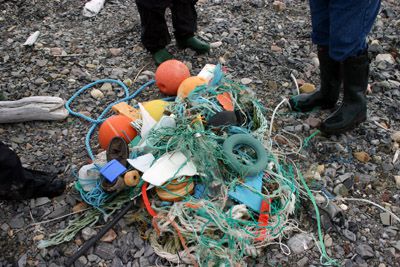
Plastic waste collected on the beach of the Hinlopen Strait, Northeast of Spitsbergen.
Reference to two projects worthy of support should not be missing here either:
The Ocean Cleanup develops technical systems with the aim of reducing a huge plastic vortex in the Pacific by 50% in five years and ultimately supplying the filtered plastic to recycling systems.
Ocean Care carries out protection and research projects, organises campaigns and educational projects and is involved in international bodies, for example as a UN special adviser on marine protection issues.
Source: Nature Communications
Unique photos of mating polar mating at the weather station on Hopen
The little island of Hopen seems to be the place currently regarding rare wildlife observations. Just a few weeks ago a polar fox attacked the station’s dogs, later it appeared to have rabies. Only a few days later, the crew of the weather station Hopen Meteo got a wildlife observation of century class. Generally, polar bear sightings are nothing unusual on Hopen. During some winters, there are several hundred polar bear observations close to the weather station. But the event observed on 04 May was truly unique!
Initially, the weather station crew thought that the two polar bears that came close to the station might be a mother and her second year cub, having a little family dispute as they kept roaring against each other.
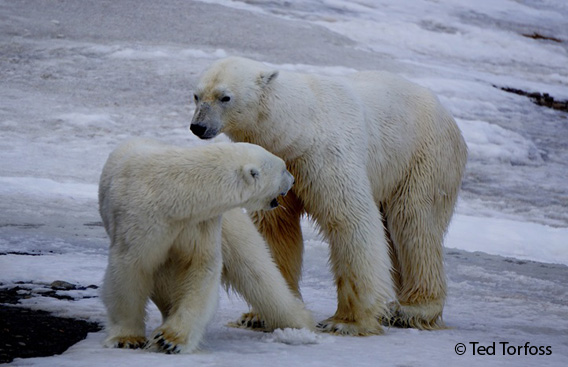
Here, the situation is not yet clear. Photo © Ted Torfoss.
Routinely, the station crew made attempts to scare the polar bears away with making noise. The bears went away, but only to return later. They had obviously been hunting successfully in the meantime, as evidenced by traces of blood on the face.
Soon it became appearent that it was not an everyday polar bear visit, but that they were a male and a female about to mate. After a while they got down to serious business.

Here the case is pretty clear: mating polar bears. Photo © Ted Torfoss
Being totally busy with themselves, the bears did not pay much attention to their surroundings but kept mating for a good hour, with obvious pleasure as the photos suggest. The 4 crew members of Hopen Meteo hence got the opportunity to enjoy an observation which is not just once in a lifetime, but much rarer actually. Obviously, they took the opportunity to take unique photos. Here are some amazing shots by meteorologist and photographer Ted Torfoss who made good use of this chance of a lifetime and I thank Ted for his kind permission to show some of his photos here! For more photos, visit the webseite of the Hopen weather station. Maybe the whole thing was a birthday present by nature to Ted Torfoss, who could celebrate his 60th birthday soon after the event? Anyway, happy birthday!
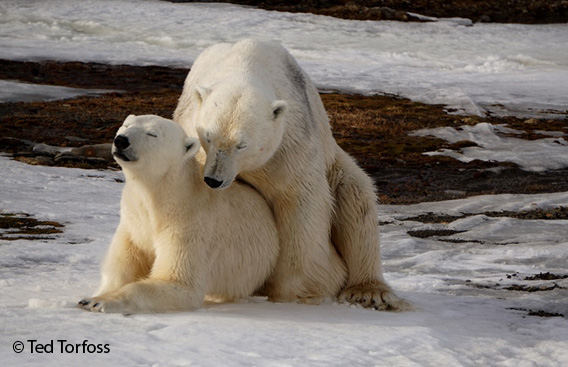
Polar bears enjoying some cosy moments. Photo © Ted Torfoss
Of course, polar bears are mating every year and the event as such is common in polar bear areas in nature at this time of year. But as a small number of individuals is spread out over immensely large and very remote areas, observations are very few and far between. There are not many photos or footage taken. No earlier observations are known from Hopen, which would be the hotspot in Svalbard for such an occasion given the density of polar bears in good ice winters and the presence of the weather station.
A few weeks ago, a group of lucky tourists also saw polar bears mating in the distance in Tempelfjord not far from Longyearbyen. Photos taken by guide Yann Rashid were seen by many on the web and have without any doubt scarcity value, but they do not compare to the photos taken from a much smaller distance by Ted Torfoss on Hopen.
Polar fox with rabies on Hopen
A polar fox was found to have rabies after having attacked dogs on the little island Hopen in southeast Svalbard, according to a note by the Sysselmannen. The fox attacked the dogs which belong to the weather station Hopen Meteo on 26 April; it was killed by the dogs during the attack. Routinely, the fox was taken to Oslo, where it was found to be infected by rabies.
Hopen is in the far southeast of Svalbard, 90 kilometres away from Edgeøya, the next large island, 200 kilometres from Spitsbergen’s east coast and almost 300 kilometres from Longyearbyen. It is, however, easily possible that other, infected polar foxes are already further west, where the settlements are located and tourists have their more common routes, or they may cover these distances quickly: most sea areas in the east of the Spitsbergen archipelago are still covered by dense drift ice, where polar foxes are known to travel large areas. It is very likely that the rabies virus came with a polar fox from arctic Russia, further away from Hopen than the main island of Spitsbergen. This is not the first time rabies is found in Svalbard; on the long term, it happens actually more or less regularly: the virus has been found no less than 7 times since 1980, including the recent incident on Hopen. The last time was in 2011, when rabies was found in reindeer and foxes on Hopen, in Hornsund and near Longyearbyen.
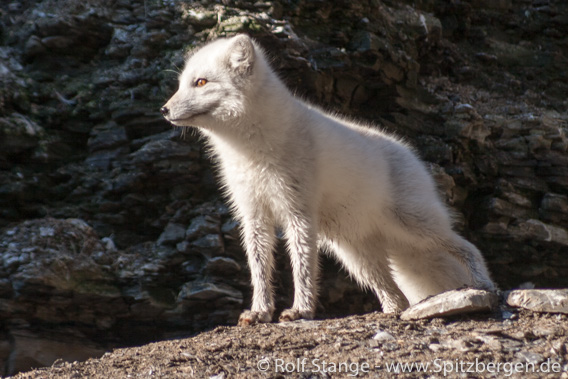
Polar fox on Edgeøya: curiosity is normal behaviour, aggression in contrast an alarm signal for rabies.
Rabies is dangerous also for humans: “If you have accidentally touched potentially infected animals, then wash your hands very carefully afterwards; washing in disinfectant is even better. Getting the virus through bare skin contact is near impossible, but matters are completely different if you have been bitten. If you suspect an infection, then it is definitely advised to contact the Sysselmannen as soon as possible. Vaccination is possible for a short while even after exposure to the virus. The risk of actually getting infected is very, very low, but if things go really wrong, then the result will be fatal.” (quotation from Spitsbergen-Svalbard guidebook)
Unusual behaviour of polar foxes including aggression towards humans or larger animals is a clear warning sign of a rabies infection.
The actual risk of infections for humans is very low and the recent episode does certainly not involve any general risk for travelling in Svalbard, but awareness of the situation is, as always, important.
Arctic rubbish: it is not allowed to die or to be born in Longyearbyen. Or: you are required by law to carry a gun
It is incredible how long-lived some rumours are. They are so persistent that they are not only often repeated by media anywhere in the world who do not do their homework, but – even worse – you can hear them locally, told as adventure stories by guides.
Still, they are rumours and the truth is different. You as a reader of this site know better or at least you will know better in a minute.
The first and maybe most often told rubbish is that it is not allowed to die in Longyearbyen. From a practical viewpoint, you may ask how to enforce such a rule or law. What happens if you actually die in Longyearbyen? Do you get a fine, or do they put you in jail? Seriously: such rumours often have a root somewhere in real history, and such is the case also here. For most of its history which goes back to 1906, Longyearbyen was nothing but a company town, completely owned by a mining company. There was no free housing market, but a company that provided accommodation to her employees. When your contract period was finished, you had to leave Longyearbyen (theoretically, you could stay elsewhere in Svalbard, as some trappers actually did!). For this simple reason, people did not die in Longyearbyen because of age (they often died from other causes, though). Even today, when you are seriously ill or you need intense care, you will be much better off on the mainland or somewhere else with advanced facilities, which do not exist in Longyearbyen. The hospital is small and not prepared to treat special cases, and there is no home for the elderly. So, if you need any of that, you fly to the mainland, for simple practical reasons.
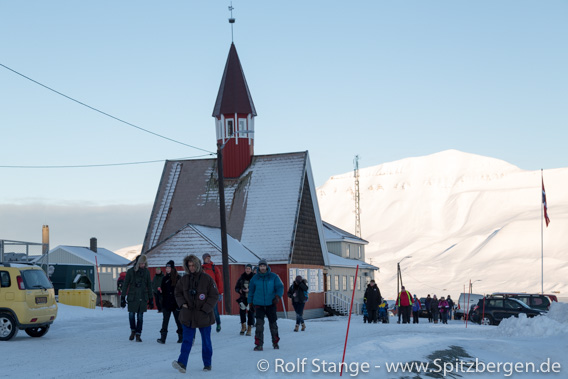
People live happily in Longyearbyen …
In case an inhabitant dies, there is often the wish to be buried in a home community in mainland Norway (or elsewhere). Only very few families are connected to Longyearbyen over generations. Most people have a stronger family connection elsewhere, so in case, they want to be buried elsewhere. If someone chooses to rest eternally on the cemetery in Longyearbyen, then this is absolutely possible. There is only one restriction: only urn burials are allowed, no coffins. The so far last burials in Longyearbyen have been in 2014, but there will be more in the future when the occasion calls for it.
This is the factual background of the rather silly rumour that it is “not allowed to die in Longyearbyen”. There is no law like that, and there has never been one.
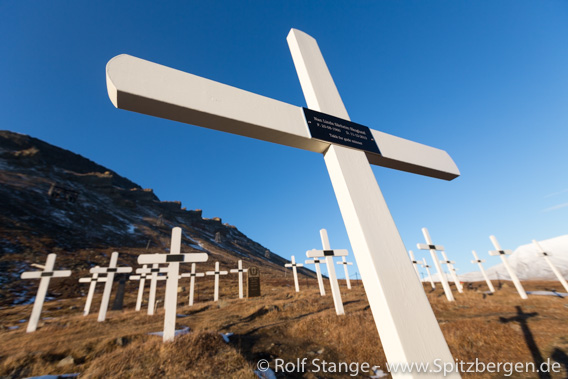
… and sometimes (rarely, though), they happen to die in Longyearbyen. There is no rule against dying in Longyearbyen.
Why are people, even guides, telling such silly things? Maybe it is the attempt to make Longyearbyen even more exciting and exotic than it actually is. Quite unnecessary, as Longyearbyen is already quite exciting and exotic as it really is. Maybe it is too much effort to make some quick research, and maybe some people think that the facts don’t matter in times of fake news (and the “rule against dying” is really more fake than news anyway). This is not the case! Things should be told as they are. One who did that regarding the right to die in Longyearbyen was local priest Leif Magne Helgesen, a while ago in a letter-to-the-editor in Svalbardposten.
While we are at it, let’s have a quick look at the other, more pleasant end of the life cycle, namely birth. When it is said that it is not allowed to die in Longyearbyen, it is also often said that it is not allowed to be born there either. That is rubbish just as well.It is only because of the above-mentioned practical reasons that pregnant women will take a flight to the mainland a few weeks before they are expected to give birth. In case of difficulties, it will be much safer to be in the university hospital in Tromsø or elsewhere in or near bigger, more advanced medical facilities, just in case. There is no law or rule of any kind against being born in Longyearbyen.
Another subject, similar level of bullshit: it is often said that people are required by law to carry a gun in Spitsbergen. Has anyone ever seen such a law? No! Because there has never been such a law. It is self-evident that your chances of survival in the worst case of meeting a really angry polar bear will be much better in case you have a suitable weapon when you are in the field in polar bear country, so it is indeed very common to carry a gun. But this is simply not required by any law! The only thing that you are legally obliged to have is some kind of deterrent, usually a signal pistol with special ammunition. If you apply for a tour permit, which you need for remote areas (outside the so-called administration area 10), then the Sysselmannen will also require that you carry a weapon for polar bear protection, but based on safety considerations and not on law. If you decide to walk outside Longyearbyen without a gun, then you may be a bit suicidal, but you don’t do anything illegal. Again: there is no law that requires anyone to carry a rifle in Svalbard!
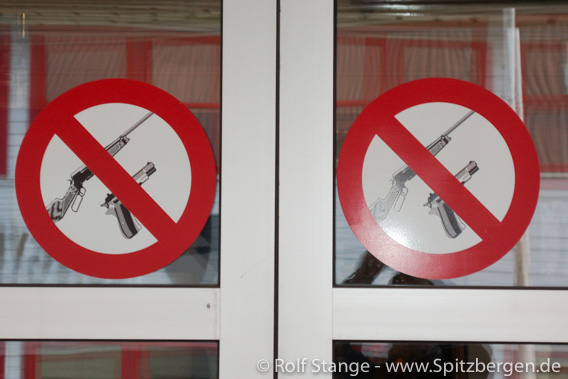
It is not forbidden to die in Longyearbyen and there is no law asking you to carry a rifle in Svalbard. Not having anything to protect you against polar bears might, however, be a life-threatening mistake.
So, now we have clearified a good bit of arctic rubbish. See you soon!
Two snow mobiles broken into fast ice in Mohnbkta at the east coast
Two snow mobiles broke through the surface of the fast ice in Mohnbukta at the east coast of Spitsbergen. Nobody suffered any injuries. Both belonged to a group of nine snow mobiles with locals from Longyearbyen out on a private tour. According to officals, the group had been careful and exercised good practice. Shortly before the incident, they had measured the ice thickness to be close to 70 cm, a value that usually indicates safe conditions.
As the individual drivers had kept sufficiently large distance between their vehicles, following ones could avoid driving into the danger zone. The drivers of the snow mobiles that had broken through the surface managed to get off and onto safe ice. The group could retrieve both snow mobiles with ropes, avoiding loss of equpment and fuel in the environment. Immediately after the incident, they informed the Sysselmannen in case anyone had seen them and raised alarm.

On tour on the ice in Mohnbukta on the east coast of Spitsbergen: beautiful, but never entirely risk-free.
The incident, which happened yesterday (Saturday), shows that fjord ice is never an entirely risk-free environment for travelling. Even with careful behaviour, risk cannot be fully excluded. Care and quick availibiity of safety equipment (ropes and “ispigger”, kind of nails with handles or something similar that helps you in the worst case to get out from the water and back onto ice) can safe lives.
Source: Svalbardposten
Arctic travel blog in the far south: Antarctica, Patagonia
Tue
24 Apr
2018
I have been asked why there has been no arctic travel blog in a while. The reason is short and conclusive: I have not been in the Arctic recently. I have been in Antarctica and Patagonia – you couldn’t be much further away from the Arctic, yet very familiar! So, there has indeed been a recent and well-fed travel blog, just from the deep south and not from the high north and accordingly on a different website (antarctic.eu, click here to get there).
The arctic travel blog will be continued in a few weeks from now, when we start the northern season under sail early in the second half of May.
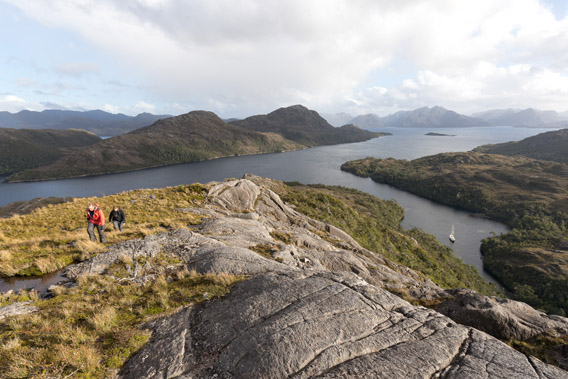
Supercool landscapes with trees? Hard to believe, but that exists! Click here to have a look at the travel blog Patagonia. But don’t worry, there is also a lot of supercool landscapes without trees in the same travel blog, from Antarctica.
Traffic ban in Tempelfjord, Billefjord and Rindersbukta
The Sysselmannen has decided to ban motorised traffic from the fjord ice in Tempelfjord (inner Isfjord), Billefjord (near Pyramiden) and Rindersbukta (in Van Mijenfjord). The ban is based on the assumed disturbance of wildlife by motorised traffic. All of these places are popular destinations for snow mobile trips from Longyearbyen. Ringed seals need the fjord ice currently to give birth to their offspring, and polar bears, which have been seen regularly in recent times in all these places, have accordingly an important hunting season to build up fat reserves. The authorities assume that the total disturbance by motorised traffic is too much for the wildlife to carry on with their important respective businesses.
Until 01 Juni – covering the complete remaining winter season – all motorized traffic is banned from the fjord ice in these areas. There are exceptions on the shortest safe routes in Billefjord from Nordenskiöldbreen to Pyramiden, which is part of the regular trip from Longyerabyen to Pyramiden, and in Tempelfjord, making it possible to cross the ice on the shortest safe route west of Kapp Schoultz to Kapp Murdoch. Maps showing the details are available on the Sysselmannen’s website.
Non-motorised traffic is not concerned.
In 2018, the fjord ice has developed better than in recent years. It is the first time in several years that Tempelfjord can be crossed regularly and safely.
Appearently wildlife is not much disturbed by careful, sensitive traffic by guided groups or careful individuals. Ruthless behaviour of careless individuals or groups is another matter and hard to control.
The Sysselmannen reminds the public that it is everybody’s indivdual responsibility to assess the safety of the ice for traffic.

Glacier front in Tempelfjord: popular destination for excursions, but currently off limits for motorised traffic.
Out now: Spectacular Antarctica postcards (limited edition)!
Travel to the Antarctic once – a dream only few can realize. Everyone else continues to dream while sending postcards with spectacular pictures from the Antarctic to their loved ones. The postcards include motifs of King and Emperor Penguin, Elephant seal, a very rare “Ecotype D” Orca and spectacular landscapes on remote Antarctic islands, including a tabular iceberg that is unique and distinctive to the Antarctic iceberg form.
>>>Order Antarctica-postcards here
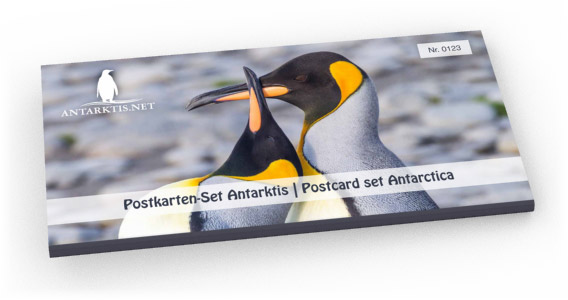
Maybe the dream of an Antarctic trip will come true some day?
Available now: New, fourth edition of the travelguide Spitsbergen – Svalbard
608 pages thick: the new guidebook Spitsbergen – Svalbard for the English-speaking audience has grown by almost 100 pages! All chapters have been updated with new details, especially maps.
>>>Click here for more information and ordering the new, fourth edition of “Spitsbergen – Svalbard”
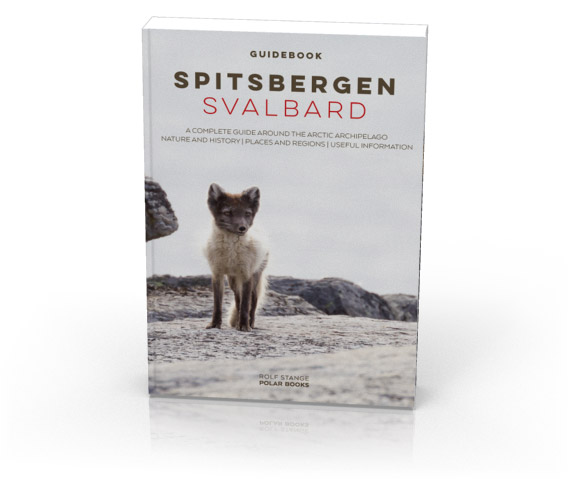
Essential for all English speaking Spitsbergen fans:
The new, fourth edition of the guidebook Spitsbergen – Svalbard
»Spitsbergen – Svalbard« has detailed information about the flora and fauna of Spitsbergen, its nature and human history and detailed chapters about all regions, fjords, islands and settlements. The various seasons are described and different ways of traveling. Routes are described in detail for popular snow mobile excursions, day hikes, long trekking expeditions and boat trips. 14 mammal species, 26 bird species and 29 flower species are described in detail and illustrated with colour photographs. Many maps within the text provide geographical orientation – these are amongst the many important improvements compared to previous editions. The polar bear risk and issues related to weapons are discussed. Detailed information about relevant legislation as well as names of all wildlife and plant species described in no less than 10 languages make the book a complete reference also for professional guides. This is by far the most complete Svalbard guidebook available on the market!
Indispensable for Spitsbergen-beginners as well as for Spitsbergen-experts
140 flats in Longyearbyen must give way to avalanche protection
Extensive avalanche protection measures are likely to change Longyearbyen’s cityscape over the next few years. This was the result of a study published by the NVE (Norwegian Water Resources and Energy Directorate) in mid-March. Thereafter, the buildings in the eastern part of Longyearbyen are classified as much more endangered than previously assumed.
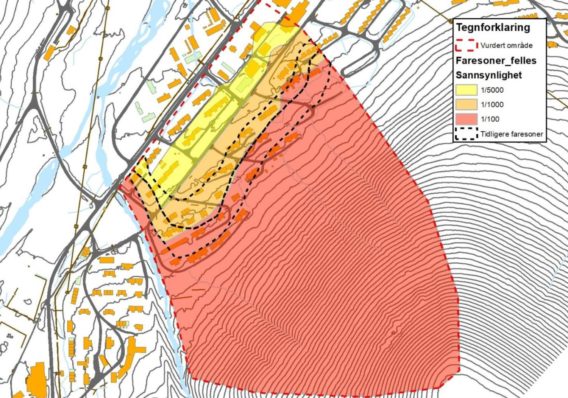
Avalanche danger zones mark the possibilities of an avalanche once in 100 years (red zone), once in 1000 years (orange zone) and once in 5000 years (yellow zone).
Picture: NVE
According to the NVE report, the danger zone reaches almost to the center, so that a number of houses with a total of around 140 flats may need to be demolished. As a protective measure, it is recommended to build a 10 to 15 meter high barrier. Where exactly the barriere should stand and which houses are affected in detail by the demolition, is still unclear. The barriere will probably extend across way 230 and 228 to Hilmar Rekstens Vei.
In addition, at the foot of Mount Sukertoppen, several “brake cones” are to be installed, which can reduce the energy of an avalanche. The “brake cones” should each be ten meters wide and eight meters high. Together with the construction of new houses as well as a planned protection against mudslides from Vannledningsdalen, the construction work will probably cost at least 100 million Norwegian kroner (about 10 million Euros). These measures should be implemented within the next three years.
In recent years, several houses in Longyearbyen have been hit by avalanches. In December 2015, a catastrophic avalanche from Mount Sukkertoppen hit 11 buildings. A 42-year-old father and a two-year-old girl died. The disaster had a huge impact on the inhabitants of Longyearbyen and forced authorities and politics to act, but reactions on the various political levels from Longyearbyen to Oslo are slow. This is frustrating people locally, who have to live with month-long evacuations.
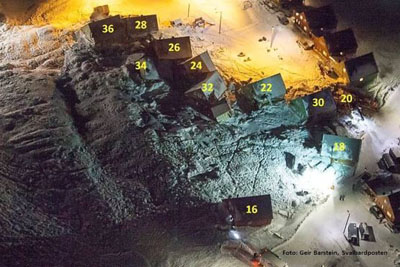
In the avalanche disaster on 19.12.2015 houses were moved up to 80 meters.
Source: Svalbardposten, NVE
New Spitsbergen postcards out now (limited edition)!
Longing for the Arctic? Or finally wanting to realize the dream of a trip to Spitsbergen? Then it’s time to convince a friend of a trip to Spitsbergen, preferably with a postcard that really awakens the longing for the Arctic. A polar bear mother playing with her cub, a yawning Arctic fox and, of course, fascinating landscapes of ice and rocks – and even more great pictures on the twelve new Spitsbergen postcards.
A set of postcards costs 10 € and the edition is limited!
>>>Order the new set of Spitsbergen postcards now!
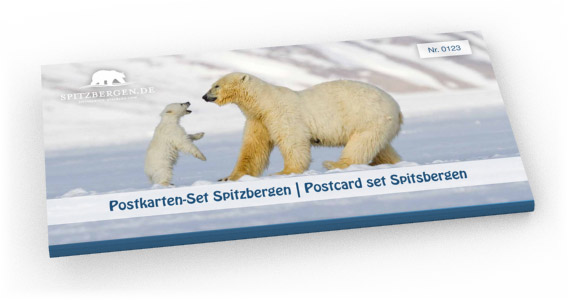
New limited edition of Spitsbergen-postcards
Remains of cosmetics found in fish
Researchers from Tromsø have found siloxanes in the liver of fish caught off Spitsbergen. Siloxanes are components in silicone products and are used to make cosmetics smooth and supple. Siloxanes are found in almost all cosmetics and skincare products. When washing or showering siloxanes get into the water circle and eventually end up in the sea.
Even for humans, these substances can be dangerous. Studies indicate that the D4 variant of siloxane may affect fertility.
Sources: NRK, Umweltbundesamt
Sun festival in Longyearbyen, new planes for Sveagruva and the travelblog soon to continue in Patagonia
The return of the sun to Longyearbyen (solfest = sun festival) was celebrated on Thursday (08 March) in good tradition. On this day, the sun returns to Lognyearbyen after several months of polar night. Just for a few moments and only if the weather is good, but that is enough reason to celebrate with several days of cultural events. This time, there was not a cloud on the sky, so everybody could enjoy the rays of the sun on the skin!

Sun festival in Longyearbyen
Meanwhile, some “old boys” around Robert Hermansen, former boss of the mining company Store Norske, try to come up with a plan to put the already abandoned coal mine settlement of Sveagruva back to life and work. Politicians have already said that they don’t appreciate such plans. For sure, there will be a lot of talking still about Sveagruva in the future.
Elsewhere, suitcases (or rather rucksacks) are being packed: on Sunday (11 March), we will start sailing in Patagonia with SY Anne-Margaretha. This means of course that the travel blog will start again soon! Please visit antarctic.eu for the southern chapters of my travel blog.
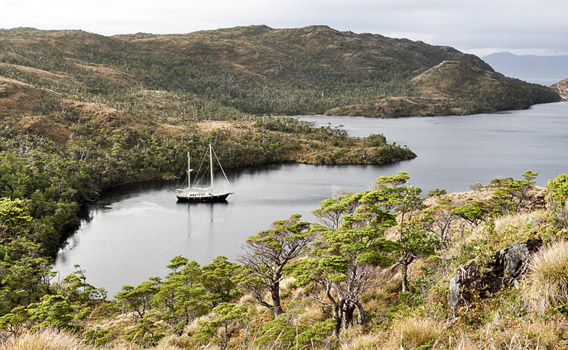
“Patagonia under sail with SY Anne-Margaretha: starting on Sunday. The travel blog will then also start soon on antarctic.eu.
Housing market in Longyearbyen: shortage, speculation and Airbnb
Longyearbyen is by many means a special place. The little town with just over 2,500 inhabitants attracts many on a seasonal or short-term basis. These people are working in tourism, but also in the building industry or in small trade or for any company that needs labour force for shorter periods. Many companies are currently facing problems to find housing for their employees, such as the tourism industry which has a very busy time now as the important winter season is in full swing. Larger companies as well as institutions such as the university (UNIS)/Polar Institute, Sysselmannen and local administration have got considerable numbers of flats for their employees to be able to compete with employers on the mainland.
Recent years have seen significant price increases for buying and renting, which has to a large degree to do with evacuations because of the avalanche danger. These evacuations have become a regular and long-lasting phenomenon now that is affecting whole streets.
As in many other places in the world, there are those owners who have dollar signs blinking in their eyes. A number of flats are rented out through Airbnb, mostly to tourists on a short-term basis. This is certainly an attractive offer for the users and it includes flats which are used by companies for their employees when there is demand, and nothing is wrong about offering these flats on the market while they are not used. But there are also those flats which are now exclusively used for Airbnb and thus not available for the local housing market anymore, a situation that is met with growing criticism both locally and elsewhere.
One of the larger owners in Longyearbyen, the mainland company Longyearbyen Boligeiendom, bought seven houses with a larger number of flats in 2012 for a price of 37 million NOK (about 4.8 million Euro back then). Rentals were soon increased by 45 %. Now, Longyearbyen Boligeiendom has announced to sell five of their seven houses with a total of 84 flats, aiming at a price of 77 million NOK. The company has said to have spent many millions on renovation, but this might well be (over)balanced by the income from rentals. Longyearbyen Boligeiendom might well leave the local market with a profit not far form 100 % of the original investment after six years. The two houses that are not (yet) for sale are in an area officially exposed to an avalanche risk, and a potential sale will not be considered before the slopes have not been secured technically. Currently, these houses would be hard to sell, if not impossible.
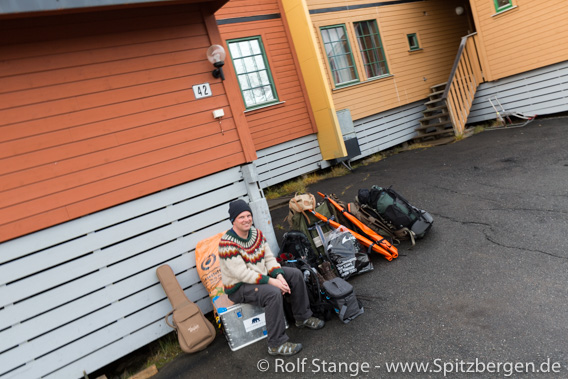
No place to stay in Longyearbyen these days? Tough luck, indeed!
On top of all this came the news that the local administration keeps a number of flats vacant. This is obviously controversial at times of a stressed housing market. It is about 24 flats in way 222 which have been vacant for months now. Large investments were made actually just last year to brush these flats up. Representatives of the local adminstration said that it was decided against renting these flats out even on shorter contracts as long as final decisions have not been made regarding the avalanche situation and securing the dangerous slopes of Sukkertoppen, a process that has already been going on for years. In addition comes that further investments need to be made to renew the foundations of the buildings. Nevertheless, it is said that the flats could be rented out and used and it seems to be a political decision to do so or not. Leaving 24 flats vacant for months, possibly years, in times of a housing market under pressure is not necessarily a decision that is met with great sympathy, while some a desparately looking for housing for themselves or their employees.
News-Listing live generated at 2025/May/09 at 18:20:40 Uhr (GMT+1)




























